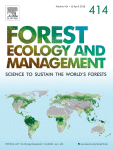Ver ítem
- xmlui.general.dspace_homeCentros Regionales y EEAsCentro Regional Buenos Aires NorteEEA Delta del ParanáArtículos científicosxmlui.ArtifactBrowser.ItemViewer.trail
- Inicio
- Centros Regionales y EEAs
- Centro Regional Buenos Aires Norte
- EEA Delta del Paraná
- Artículos científicos
- Ver ítem
Yield stability and phenotypic plasticity of Populus spp. clones growing in environmental gradients: I-yield stability under field conditions
Resumen
Populus species have been extensively cultivated in different regions around the world due to their growth performance, easy vegetative propagation and wood properties (for lumber, pulp, fiberboard and plywood). Stability analysis is important for forest breeding programs aimed at obtaining high yield genotypes with greater adaptability for a wide range of environments. However, its application in woody species is scarce in comparison to the usual
[ver mas...]
Populus species have been extensively cultivated in different regions around the world due to their growth performance, easy vegetative propagation and wood properties (for lumber, pulp, fiberboard and plywood). Stability analysis is important for forest breeding programs aimed at obtaining high yield genotypes with greater adaptability for a wide range of environments. However, its application in woody species is scarce in comparison to the usual approach for annual crops. Our objective was to study the productivity and stability of poplar clones across different environmental conditions, and to compare two different methods to characterize yield stability. We used data obtained from trials across sites with different environmental conditions in Paraná River Delta, South America. The studied clones were the most used in the region, Populus deltoides W. Bartram ex Marshall ‘Australiano 129/60’, ‘Carabelas INTA’, ‘Stoneville 67’ and Popupus x canadensis Moench ‘Ragonese 22 INTA. We analyze their growth response in long-term trials under field conditions in a context of high environmental heterogeneity such as the leveed systems of the studied region. Yield stability (volume/ha) of poplar clones was evaluated at eight years old from parameters of Joint Linear Regression Analysis (regression coefficient bi and squared deviations from the mean δij), and with a simplified Relative Distance Plasticity Index (RDPIs) assuming that lower RDPIs implies greater genotype yield stability. This comparison highlighted the usefulness of RDPIs to estimate yield stability regardless of the set and number of involved genotypes. The amplitude of yield between sites demonstrated a great environmental heterogeneity and the significance of genotype x environment interactions. These genotypes were selected clones but had great differences in stability and yield. Thus they were classified as stable genotypes of high yield (‘Australiano 129/60’) and low yield (‘Stoneville 67’) and unstable genotypes of high yield (‘Carabelas INTA’) and low yield (‘Ragonese 22 INTA’). The description of ‘Australiano 129/60’ as stable genotype of high yield is consistent with the empirical perception of forest farmers and explains the prevalence of this clone in the poplar plantations at the Paraná River Delta. However, ‘Carabelas INTA’ an unstable genotype was the best alternative for the most productive conditions. Thus, evaluating yield stability was relevant for both strategies, the selection of high yield stable genotypes and to identify the best genotype for a specific environment. Moreover, the combination of them according to site conditions and resource availability could improve the yield at a stand or regional level. Yield stability analysis should be considered as selection criteria of new clones in Populus breeding programs considering the range of site conditions and the potential impact of climate change on forest plantations.
[Cerrar]

Fuente
Forest Ecology and Management 463 : 117995 (May 2020)
Fecha
2020-05
Editorial
Elsevier
ISSN
0378-1127
Formato
pdf
Tipo de documento
artículo
Palabras Claves
Derechos de acceso
Restringido
 Excepto donde se diga explicitamente, este item se publica bajo la siguiente descripción: Creative Commons Attribution-NonCommercial-ShareAlike 2.5 Unported (CC BY-NC-SA 2.5)
Excepto donde se diga explicitamente, este item se publica bajo la siguiente descripción: Creative Commons Attribution-NonCommercial-ShareAlike 2.5 Unported (CC BY-NC-SA 2.5)

